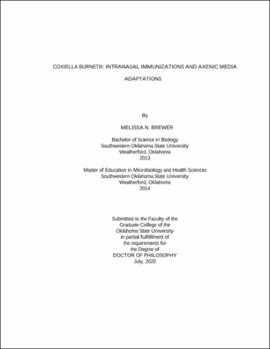| dc.contributor.advisor | Lutter, Erika | |
| dc.contributor.author | Brewer, Melissa N. | |
| dc.date.accessioned | 2021-02-22T22:24:22Z | |
| dc.date.available | 2021-02-22T22:24:22Z | |
| dc.date.issued | 2020-07 | |
| dc.identifier.uri | https://hdl.handle.net/11244/328638 | |
| dc.description.abstract | Coxiella burnetii is an obligate intracellular pathogen and the causative agent of the zoonotic illness Q fever. With an infectious dose of 1-10 organisms, C. burnetii is one of the most infectious bacteria known. This low infectious dose coupled with its environmental stability and aerosol route of infection has placed it on the Centers for Disease Control and Prevention's Class B Select Agent List, making a vaccine against C. burnetii infection particularly desirable. Formulations of killed whole-cell C. burnetii virulent strains has been shown to be effective when administered intramuscularly, intraperitoneally, and sub-cutaneously, but has not been assessed using an intranasal route of inoculation that would also bring to bear the mucosal immune response. We hypothesized that intranasal immunization would be protective against subsequent challenge with live virulent C. burnetii. Using a guinea pig model, intranasal immunization with either a mixture of killed whole-cell C. burnetii Nine Mile phase I combined with double mutant lethal toxin (DmLT) adjuvant, or a mock immunization of PBS-DmLT. Booster immunizations were administered at 14 and 28 days. Sera was drawn for IgG titers prior to, and at 14, 28, and 56 days following intranasal immunization. Analysis of sera indicates that a robust humoral response is elicited following intranasal immunization. Additionally, immunized guinea pigs that were subsequently challenged with virulent C. burnetii NMI did not develop significant clinical symptoms as measured by fever and weight loss when compared to animals receiving the mock immunization. Studies defining minimal immunization requirements, potential hypersensitivity response, and protective antigen profile using this physiologically relevant exposure route will aid us in defining a protective response to this unusual aerosol acquired pathogen. | |
| dc.description.abstract | For the first 80 years following its discovery, C. burnetii could only be grown in a system providing live cells within which it would replicate. The relatively recent advent of cell free media has been a boon for C. burnetii research on many fronts. We noticed when infecting cultured cells using C. burnetii that had been repeatedly passaged in cell free defined acidified citrate cysteine media (ACCM-D), that the infectivity rates were lower than expected based on the number of genomes used to initiate the infection relative to C. burnetii that had been derived from infected cells. Infectious assays comparing C. burnetii from passages 1, 3, 5 and 10 determined that by passage 10 the organism's relative ability to infect cultured cells had decreased 2-logs. We hypothesized that molecular changes were occurring in these early passages that related to the ability of the bacteria to infect or grow within host cells at their normal rate. We initiated a "Reverse Evolution" approach to study the molecular changes that occur following serial passages in axenic media to determine what occurs when the stressors associated with C. burnetii's typically intracellular lifestyle are removed. We found that the concentration of DotA and IcmX, two structural proteins of the Type IVB Secretion System, which is required for intracellular growth, were significantly reduced by passage 10. Mass spec analysis of passages 1, 3, and 5 also demonstrate changes between protein levels in subsequent passages analyzed. Expanded mass spec and RNAseq analysis to include passage 10, along with immunoblot analysis and genome sequencing of both early and longer-term passages will elucidate molecular mechanisms required for C. burnetii's intracellular survival and growth. | |
| dc.format | application/pdf | |
| dc.language | en_US | |
| dc.rights | Copyright is held by the author who has granted the Oklahoma State University Library the non-exclusive right to share this material in its institutional repository. Contact Digital Library Services at lib-dls@okstate.edu or 405-744-9161 for the permission policy on the use, reproduction or distribution of this material. | |
| dc.title | Coxiella burnetii: Intranasal immunizations and axenic media adaptations | |
| dc.contributor.committeeMember | Shaw, Edward | |
| dc.contributor.committeeMember | Patrauchan, Marianna | |
| dc.contributor.committeeMember | Prade, Rolf | |
| dc.contributor.committeeMember | Wozniak, Karen | |
| dc.contributor.committeeMember | Oomens, Tom | |
| osu.filename | Brewer_okstate_0664D_16827.pdf | |
| osu.accesstype | Open Access | |
| dc.type.genre | Dissertation | |
| dc.type.material | Text | |
| thesis.degree.discipline | Microbiology and Molecular Genetics | |
| thesis.degree.grantor | Oklahoma State University | |
